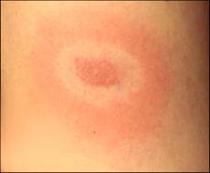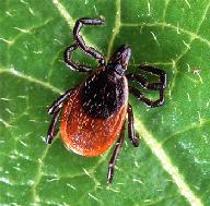It's a New Day in Public Health.
The Florida Department of Health works to protect, promote, and improve the health of all people in Florida through integrated state, county, and community efforts.
Lyme Disease
Florida Health
Disease Control- DiseaseControl@flhealth.gov
- 850-245-4444
-
Florida Health
4052 Bald Cypress Way
Tallahassee, FL 32399
Lyme disease (LD) is caused by a bacterium known as Borrelia burgdorferi. It is transmitted to people through the bite of an infected tick. In the southeastern U.S. the black-legged tick (Ixodes scapularis) is the suspected vector. The disease was first identified along the Connecticut River in 1975, and is the most commonly reported vector-borne disease in the United States. However, most cases are reported in the northeastern, Mid-Atlantic, and north central regions of the country.
- SYMPTOMS AND TREATMENT
- TRANSMISSION
- LYME DISEASE OCCURRENCE IN FLORIDA
- RESOURCES

Between 60 and 80% of people will develop a red, "bull's eye" rash (erythema migrans or EM) three to 30 days after being bitten by an infected tick. This rash does not always appear at the site of the bite, and may occur on another part of the body. Other symptoms include fever, headache, chills, fatigue, stiff neck or muscle aches. Later stage symptoms may not appear until months or years after the bite and can include problems with the brain, heart, joints and muscles. Patients treated with antibiotics early after the infection usually recover quickly and completely. A few patients, especially those diagnosed in the later stages of disease, may have persistent or recurrent symptoms. These patients may benefit from a second course of antibiotic therapy. However, longer courses of antibiotic treatment have not been shown to be beneficial and have been linked to serious complications.
 Normally, the life cycle of the black-legged tick begins with eggs in the spring. The eggs hatch into larvae and then feed once before they molt into nymphs and go dormant until the following spring. Then they feed again and molt into adults. The larvae and nymphs feed on rodents, and it is usually at this stage when the tick becomes infected. The nymphs and adults feed on larger mammals, including humans. Most humans are infected through the bites of nymphs. Studies have shown that both nymph and adult ticks need to be attached for more than 24 hours to effectively transmit the infection. For this reason, it is important to regularly check for ticks and remove them immediately.
Normally, the life cycle of the black-legged tick begins with eggs in the spring. The eggs hatch into larvae and then feed once before they molt into nymphs and go dormant until the following spring. Then they feed again and molt into adults. The larvae and nymphs feed on rodents, and it is usually at this stage when the tick becomes infected. The nymphs and adults feed on larger mammals, including humans. Most humans are infected through the bites of nymphs. Studies have shown that both nymph and adult ticks need to be attached for more than 24 hours to effectively transmit the infection. For this reason, it is important to regularly check for ticks and remove them immediately.
*Note: This page contains materials in the Portable Document Format (PDF). The free Acrobat Reader may be required to view these files.



Connect with DOH